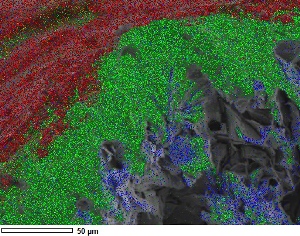Sep 5 2014
Research from North Carolina State University shows that a type of modified titania, or titanium dioxide, holds promise as an electrical insulator for superconducting magnets, allowing heat to dissipate while preserving the electrical paths along which current flows. Superconducting magnets are being investigated for use in next-generation power generating technologies and medical devices.
 Energy dispersive x-ray spectroscopy image taken within a scanning electron microscope, illustrating a Bi2212 wire shown in blue and green, coated with the titania-based insulation shown in red. Image credit: Sasha Ishmael.
Energy dispersive x-ray spectroscopy image taken within a scanning electron microscope, illustrating a Bi2212 wire shown in blue and green, coated with the titania-based insulation shown in red. Image credit: Sasha Ishmael.
Regular conductors conduct electricity, but a small fraction of that energy is lost during transmission. Superconductors can handle much higher currents per square centimeter and lose virtually no energy through transmission. However, superconductors only have these desirable properties at low temperatures.
“Superconducting magnets need electrical insulators to ensure proper operation,” says Dr. Sasha Ishmael, a postdoctoral researcher at NC State and lead author of a paper describing the work. “Changing the current inside the superconductor is important for many applications, but this change generates heat internally. The magnets will operate much more safely if the electrical insulators are able to shed any excess heat. Otherwise, the higher temperatures could destroy the superconductor.
“This titania-based material is up to 20 times better at conducting heat than comparable electrical insulators,” Ishmael says. “It has characteristics that are very promising for use as electrical insulators for superconducting technologies.”
The precise chemical composition of the modified titania is proprietary information. The material’s development and characterization was a joint effort between NC State and nGimat LLC, based in Lexington, Kentucky.
“We’re now looking at the effect of radiation on this material, to determine if it can be used for high energy physics applications, such as particle colliders,” says Dr. Justin Schwartz, senior author of the paper and Kobe Steel Distinguished Professor and head of the Department of Materials Science and Engineering at NC State.
The paper, “Thermal conductivity and dielectric properties of a TiO2-based electrical insulator for use with high temperature superconductor-based magnets,” is published online in the journal Superconductor Science and Technology. The paper was co-authored by M. Slomski, H. Luo, J.F. Muth, T. Paskova, and W. Straka of NC State, and M. White, A. Hunt, N. Mandzy, and R. Nesbit of nGimat LLC.
The research was supported by the Department of Energy under grant DE-SC0004657-001 and the National Science Foundation under grant CBET-1336464.
Source: http://www.ncsu.edu/